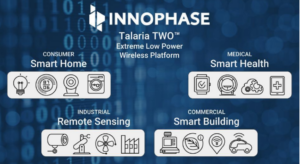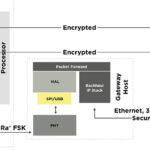 InnoPhase, a new fabless semiconductor company specializing in extreme low power wireless solutions, announces the Talaria TWO platform, a complete wireless IoT solution integrated on a single chip. It contains a full functionality multiprotocol transceiver, MAC/PHY, digital power amplifier and an embedded ARM processor for lightweight applications. The Talaria TWO chip is designed for battery-based IoT applications and is optimized to be the lowest power Wi-Fi solution in the industry. It has the potential to create a whole new class of IoT products that can cut the power cord and be battery-based with a DTIM3 specification at least half that of leading low-power Wi-Fi solutions.
InnoPhase, a new fabless semiconductor company specializing in extreme low power wireless solutions, announces the Talaria TWO platform, a complete wireless IoT solution integrated on a single chip. It contains a full functionality multiprotocol transceiver, MAC/PHY, digital power amplifier and an embedded ARM processor for lightweight applications. The Talaria TWO chip is designed for battery-based IoT applications and is optimized to be the lowest power Wi-Fi solution in the industry. It has the potential to create a whole new class of IoT products that can cut the power cord and be battery-based with a DTIM3 specification at least half that of leading low-power Wi-Fi solutions.“Power consumption has typically limited the potential of battery-powered, wirelessly connected products. The frequency of battery changes can be a hassle to consumers, a prohibitive cost to service-oriented companies, and something product OEMs are increasingly cautious of,” said Phil Solis, research director at IDC. “Innovative, low-power wireless connectivity designs, such as those from InnoPhase, are increasingly sought for new and better product designs, opening the door to a wider range of battery-powered IoT products – an increasingly larger portion of the approximately 4 billion Wi-Fi-enabled products that now ship each year.”
The Talaria TWO platform uses InnoPhase’s revolutionary patented PolaRFusion radio architecture, which processes radio signals using polar coordinates rather than traditional IQ coordinates. This digitally-intensive radio solution dramatically reduces the amount of power required to transmit, process, and receive wireless information using industry standard wireless protocols. It achieves this by moving most of the radio signal processing from power-hungry analog circuits, found in today’s IQ-architecture wireless solutions, into power and size efficient digital logic.
The product provides maximum flexibility by actively managing multiprotocol coexistence for 802.11b/g/n and BLE 5.0 for demanding edge-of-network applications. Initial customer products developed using the Talaria TWO wireless platform have shown battery life improvements of more than 50% versus competitive solutions. Products will now be able to go weeks, months or even years longer between battery charging or replacement.


Leave a Reply